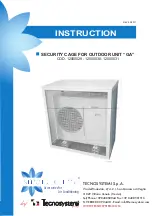
Refrigerant Connections for Air-Cooled Units
Liebert
®
CRV
™
38
6.5.2 Piping Guidelines for Liebert MC and Fin/Tube Condensers
The following operations must be carried out by an experienced refrigeration technician.
NOTICE
Risk of oil contamination with water. Can cause equipment damage.
The piping must not be open to the atmosphere for extended periods because the Liebert CRV
requires POE (polyol ester) oil. POE oil absorbs water at a much faster rate when exposed to
air than previously used oils. Because water is the enemy of a reliable refrigeration system,
extreme care must be used when opening systems during installation or service. If water is
absorbed into the POE oil, it will not be easily removed and will not be removed through the
normal evacuation process. If the oil is too wet, it may require an oil change. POE oils also
have a property that makes them act as a solvent in a refrigeration system. Maintaining
system cleanliness is extremely important because the oil will tend to bring any foreign
matter back to the compressor.
1. When installing the refrigerant piping, note the following:
• Brazing:
• All joints must be brazed.
• Avoid butt brazes by using couplings or swaging one of the pipes with a swaging tool.
• Ensure that all brazed joints are leak-free.
• Flow dry nitrogen through the pipes during brazing.
• Always use large-radius curves (bending radius at least equal to pipe diameter). Bend the pipes
as follows:
• soft copper: bend by hand or use bending device;
• hard copper: use preformed curves.
• To minimize oxidation, avoid overheating the pipes when brazing.
2. Connect the pipes to the condenser:
• Condensers with butt-brazed pipe connections: Cut the pipe, enlarge it and braze it to the
pipeline.
Respect the direction of refrigerant flow. (See labels on refrigerant.)
3. Wash out the pipelines as follows:
a. Plug up the free ends of the pipes.
b. Connect a helium or nitrogen cylinder, fitted with a reducer (maximum pressure 10 bar), to
the 1/4" SAE Schrader valve of the condenser.
c. Pressurize the pipes with helium or nitrogen.
d. Unplug the pipes instantaneously.
e. Repeat
Steps a
through
d
several times.
This operation is especially important when hard copper piping is used.
4. Open all the shutoff valves on the room unit.
5. Discharge the room unit pressurized with helium (at 1 bar) by opening the charge valves so that
all the branches of the circuit are discharged (e.g., on the receiver, on the low pressure side and on
the compressor delivery).
6. Cut the spun-closed ends off the hot gas and liquid line connections on the Liebert CRV.
7. Fix (braze) the pipes to the connections on the air conditioner.
8.
Air-Cooled Units
—Connect the refrigerant safety pressure relief valve to the outdoors with a
5/8" (16mm) copper pipe if hot gas and liquid isolation valves are installed in the field.
NOTE
Not required on water/glycol units have a indoor relief valve.
















































